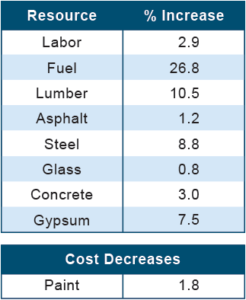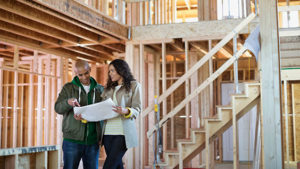Reconstruction cost – or replacement cost – is the cost of hiring a contractor to replace your home as it is, using materials and design of the same or similar quality. This amount is not the same as market value, which is the value of comparable homes that have sold in your area. Your home’s current reconstruction cost could be very different from its market value.
The U.S. economy is growing, unemployment is low, wages are up and all signs point to increased construction activity and costs. However, supply issues in all facets of construction – building lots, labor and materials – are affecting these activities.
As a result, construction costs are rising. Material cost increases are the highest they have been in six years, and labor is more difficult to find. It was challenging to secure labor and materials before the hurricanes and wildfires in 2017, and now the repairs and rebuilding efforts are putting even more stress on construction costs, according to published producer price index figures.

2018 CONSTRUCTION TRENDS
According to Lorman Education Services, builders and contractors will undoubtedly adjust their costs to match the construction industry. Here are a few trends that could affect how they conduct business:
- Improving technologies – There is no doubt technological advancements have improved construction methods — from mobile technologies to the Cloud and the ability to communicate across multiple venues. Expect to see more virtual reality and augmented reality use for projects. Advances in technologies like 3D printing, drone use, self-driving vehicles and more efficient coatings for specific surfaces will affect construction costs.
- Increased spending growth – Construction demands continue to increase worldwide, for both residential and non-residential building.
- Increased modular construction – With speed being a major factor in construction today, the industry likely will see more modular construction projects. Pop-ups and permanent modular buildings for national companies could become the hottest construction trend. These types of construction are becoming much more energy-efficient, which is always attractive to homebuyers and commercial businesses.
- Increased safety measures – According to Lorman Education Services, statistics still show construction as the leader in all industry workplace accidents. This is expected to slowly improve for the coming year with better technologies and procedures. Safety mobile apps can help prevent accidents and provide better communication and OSHA compliance.
- Economizing – Price increases for supplies and skilled labor shortages are plaguing the construction industry. To reduce expenses, technologies like wearables (such as, the Spot-R by Triax™, XOEye Smart Glasses and DAQRI Smart Helmet™) can better track equipment and how laborers work. More thorough metrics and monitoring are likely the key to offsetting rising costs.
Contact Landmark Risk Management & Insurance to ensure your replacement cost coverage limits have kept up with the rising cost of construction.
Coverages described here are in the most general terms and are subject to actual policy conditions and exclusions. For actual coverage wording, conditions and exclusions, refer to the policy or contact Landmark Risk Management & Insurance.

